
Military Contours Of The Russo-Ukraine War

The world is presently captivated by the ongoing Russia-Ukraine crisis, which saw Russia commencing the invasion of Ukraine on 24 February this year. This operation is a fallout of the Russia- Ukraine conflict that has been burning since 2014. The present Russia-Ukraine War (RUW) is the largest scale of conventional military conflict that Europe has witnessed since World War II!
Build-up to the Russia Ukraine War
The seeds for the present conflict seem to have been sown exactly eight years ago, when the Revolution of Dignity took place in Ukraine in February 2014, culminating in the Ukrainian Government being overthrown. This event was quickly followed by Russia’s annexation of the 27,000 square km of Crimean Peninsula in March 2014. Russian-backed separatists then captured the Donbas- a region in Eastern Ukraine controlled by the separatist Republics of Donetsk and Luhansk. This effectively sparked an ongoing conflict in the region.
The present build-up to the RUW gained impetus in March 2021, when Russia started amassing military forces along its border with Ukraine, leading to global fears of an impending Russian invasion (a term that Russia still refuses to use). While some relief in the form of partial withdrawal of Russian troops was seen in June 2021, this was short-lived and late 2021 saw further build-up of Russian troops in the North/Northeast, East and South of Ukraine. This interim period also witnessed hostile rhetoric from Russia, including Russian President Vladimir Putin championing the views of a united Russia akin to the former Soviet Union, questioning Ukraine’s right to Nationhood and voicing concerns over threat to Russia’s security from NATO, especially in case of Ukraine joining the latter.
Events came to a head when, on 21 February 2022, the Russian President formally recognised the Donetsk and Luhansk Peoples’ Republics, much to Ukraine’s chagrin. A day later, the Russian Federation Council overwhelmingly voted for and authorised use of military force against Ukraine. Consequently, at 0500 hours Eastern European Time (approximately 0830 hours IST), the Russian President announced the military invasion of Ukraine, thus sparking the commencement of the present RUW.
Contours of the RUW
The two-week-old RUW has reportedly seen Russia commit 95% of its amassed combat forces, as reported by a leading US online news platform. Actual figures will need confirmation. However, what is clear is that the Russian offensive was launched from the North and North- Northeast of Ukraine, towards Kyiv and Kharkiv, from the East through the Donbas Region and from the South across the Crimean Peninsula in the direction of Mariupol and Kherson (refer the map below).

Broad Contours of RUW-24 Feb to Present (Zoom to See): Source-Wikipedia
Russian Armed Forces along with friendly separatist forces significantly outnumber the Ukrainian and allied volunteer forces, with Russia already reported to have committed close to 1,50,000 troops in the war. A head-to-head comparison of land forces can be seen in the exhibit below.

A Head to Head Comparison of Land Forces: Source-International Institute of Strategic Studies
The Russian and Ukrainian Order of Battle (ORBAT) for the RUW will provide detailed information for interested readers on force levels/weapon profiles and can be seen in the tables below. It must be noted that the data contained is based on open-source information from Wikipedia/ assessment of the author and does not cater for frequent grouping/re-grouping of forces that is bound to take place in conflict.
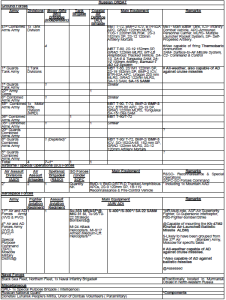
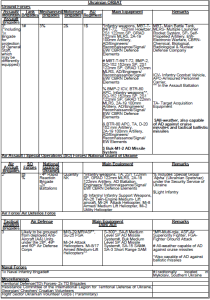
Equipment Profile: Major Equipment
While the arsenals enumerated in the ORBATs are extensive, certain equipment, as indicated in bold letters as also equipment that has been reported to have seen action in the ensuing RUW is profiled below.
Barnaul-T AD C2 System. The Barnaul-T Advanced AD Command & Control System, in use with the Russian Ground Forces (RGF), significantly enhances capability of air space surveillance and tracking of aerial targets. Information obtained can be seamlessly shared with deployed AD units for quick interception. The MP-D (Planning Module) and MRU-D (Intelligence & Control Module) air-droppable amphibious C2 vehicles make up the system and are based on an APC chassis. The MRU-D is provided with a radar and is capable of locating/tracking low-altitude UAS, helicopters, and ground-attack aircraft targets at a range of 40 km, while the MP-D is capable of detecting targets at 150 km. Both modules are capable of simultaneously tracking up to 100 different targets. The system is also reported to be capable of providing inputs to shoulder-fired (MANPADS) AD weapons.
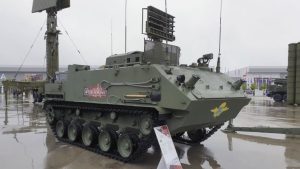
MRU-D Module of the Barnaul-T AD C2 System: Source- world-defense.com
TOS-1. The TOS-1 is a Soviet/Russian 220 mm MLRS capable of mounting unguided thermobaric rockets and was designed to attack fortified positions and lightly armoured/troop-carrying vehicles, particularly in open terrain. These rockets create an oxygen-eating fireball followed by a powerful shockwave and are significantly more powerful than conventional weapons. Thermobaric ammunition has been at the centre of controversy in the RUW, with the Ukrainian Government and Human Rights groups accusing the RGF of using this ammunition against Ukrainian soldiers and civilians (read more about thermobaric ammunition @ https://chanakyaforum.com/thermobaric-weapons-why-should-they-be-banned/). The MLRS is mounted on a T-72 MBT chassis and is capable of firing its arsenal of 24/ 30 rounds in 15 seconds at an effective range of 3500- 6000m. The latest variant, TOS-2, was first seen during a Russian exercise in September 2020. It is based on a Ural all-terrain vehicle and mounts the more powerful TBS-M3 rocket with increased range.

TOS-1A with Thermobaric Ammunition: Source-Wikipedia
SA-15 ‘Tor’ AD System. SA-15 Tor-M1 AD System with the RGF is the successor to the Osa SA-8 SAM system. This is an air-portable, tracked, low-to-medium altitude SAM system designed for intercepting aircraft, cruise missiles, precision-guided munitions (PGM), UAS and ballistic missiles. The system is fully autonomous, though it can be incorporated into existing AD Control & Reporting (C&R) systems. The principal advantage of the Tor-M1 is its ability to simultaneously track 48/destroy 2 targets at a distance of 12 Km/altitude of 6 Km, after identifying them at 25 Km, with the help of two surveillance & tracking radars. The Tor-M2 can engage four targets simultaneously at 16 Km, while the Tor-E2, unveiled in 2019, can detect targets at 32 Km, to engage them at a range of 16 Km and altitude of 12 Km.

SA-15 TOR-M1: Source-missilethreat.csis.org
Buk-M1-2 (SA-17 Grizzly) AD Missile System. This AD system is a SP, medium range SAM system developed by USSR/Russia, which can counter cruise missiles, smart bombs, aircraft, helicopters and UAS. The system has been seen on the ORBAT of the Ukrainian Ground Forces (UGF) in the RUW. Target acquisition/engagement is achieved at a range of 140 Km/42 Km respectively and at an altitude of 25 Km, with a kill probability of 90- 95% by a single missile. A standard Buk unit (three batteries) consists of a command vehicle, target acquisition radar (TAR), six TEL-and-radar (TELAR) vehicles for tracking, radar guidance & launch and three TELs.

Buk-M1-2 (SA-17 Grizzly) AD Missile System: Source- https://www.armyrecognition.com/
S-400/ S-300/ SA-22. The S-400 Triumf AD system (in use with the RGF), capable of engaging aerial targets at ranges of 400 Km and its predecessor, the S-300 (in use with the RGF & UGF) have been profiled in detail @ https://chanakyaforum.com/s-400-triumf-transforming-indias-air-defence/). The Pantsir SA-22 Greyhound is a short-range AD system, with a range of 18 Km, developed from the Tunguska AD system. It is in use with the RGF and is capable of engaging a variety of aerial targets. The system is based on a tracked chassis and carries 12 ready-to-launch SAMs with radio-command guidance, along with two twin-barrel AA guns. The missiles have no seekers, instead tracking is provided via the launcher vehicle’s radar system.

The Pantsir SA-22 SAM System: Source- Wikipedia
BMP-3 ICV. The BMP-3 ICV, in use with the RGF, is a successor to the BMP-1/BMP-2 ICVs- the latter in use with the UGF and also part of the arsenal of India’s mechanised forces. The BMP-3 mounts a turret with a 100 mm gun/launcher, capable of firing shells or the 9M117 Bastion Anti-Tank Guided Missile (ATGM). The ICV can also mount a 30 mm cannon and two 7.62 mm machine guns, as well as the Baikal Remote Controlled Weapon Station (RCWS). The ICV can carry a crew of 3 and 7-9 personnel. It has an operational range of 600 Km, with a top speed of 72 Kmph and a mass of 18.7 tons, making it much lighter than most ICVs today. Russia had offered the ICV to India, but the offer was declined in favour of India’s indigenous Futuristic ICV (FICV) Program.
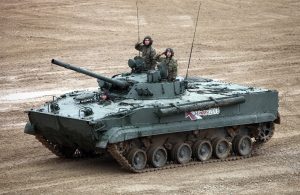
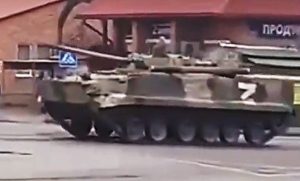
BMP-3 ICV, Screen Grab of BMP-3 Passing Through a Ukrainian Village: Source-Wikipedia/ YouTube
Fighter Aircraft. The Su-35 and Mig-31 are both frontline MR Fighters /ASF in use with the Russian Aerospace Force, with more than 100 aircraft of each in the inventory. The Su-35 Flanker E is an improved variant of the Su-27M, the Soviet Moniker for the aircraft, as well as a successor of the Su-25 Frogfoot, a single-seat, twin-engine subsonic FGA in use with the Ukrainian Air Force. The Su-35 has an empty weight of 18.4 tons and a maximum take-off weight of 34.5 tons-implying a significant payload capacity, including fuel. The aircraft has a top speed of close to Mach 2, with a combat range of 1600 Km. Armament includes 30mm cannon with 150 rounds, various free-fall bomb configurations, R-27 series of Air-to-Air Missiles (AAM) and Kh series of Air-Launched Cruise Missiles (ALCM)/Anti-Ship Cruise Missiles (ASCM). The aircraft has been exported to various countries including China, with the latter receiving 24 aircraft between 2016 & 2018. India has expressed interest in an upgraded version of the aircraft with stealth characteristics to contribute towards fulfilling the requirement for 114 Medium Multi-role combat aircraft (MMRCA) in the IAF’s inventory. The MiG-31 Foxhound is a supersonic interceptor, an improvement over the MiG-25 and a successor to the MiG-29 Fulcrum– a twin-engine MR Fighter/ASF with a top speed of Mach 2.25 and a combat range of 1430 Km, in use with the Ukrainian Air Force as well as the IAF. The MiG-31 is among the fastest combat aircraft in the world with a top speed of Mach 2.83 and a combat range of 1450 Km. Armament includes 23mm cannon with 800 rounds (removed in latest productions), R series of AAM, anti-radiation missile (ARM) and Kh-47M2 Kinzhal nuclear-capable hypersonic air-launched ballistic missile (ALBM). The Kinzhal can be fired from the MiG-31 as well as the Tupolev Tu-22M strategic bombers. Russia is the main user with 103 aircraft, with limited numbers having been exported to Kazakhstan.



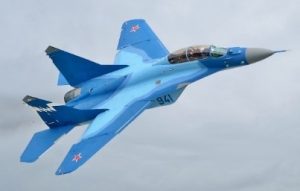
Su-35S, MiG-31, Su-25, MiG-29:Source-Wikipedia
Mi-24 Attack Helicopter, Mi-17/ Mi-8M Armed/ Transport Helicopters. The Mi-24 Hind is an attack helicopter (AH) in use with the Russian and Ukrainian Air Forces. The four-rotor AH also has a troop-carrying capacity of upto eight passengers. It has a maximum take-off weight of 12 tons, a top speed of 335 Kmph, range of 450 Km and a service ceiling of 4900m. Armament includes a 23 mm cannon, B-8V20 rocket launchers and the 9K114 Shturm radio-guided ATGM with a range of 5 Km, mounted in pairs on the outer and wingtip pylons. The export variants of the AH(Mi-25/35) are in use in a number of countries, including India. The Mi-17 (designated Mi-8M for the Russian Aerospace Force) is a transport/armed helicopter with a top speed of 280 Kmph, range of 800 Km and a service ceiling of 6000m. Armament includes 23 mm gun pods, SA-8 rockets, Ataka ATGMs and PGM. Both the above helicopters are being employed by both Russia and Ukraine in the RUW.
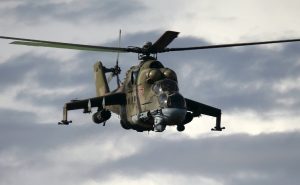

Russian Mi-24 AH, Mi-17 Transport Helicopter/Gunship:Source-Wikipedia
OTR-21 Tochka (SS-21Scarab). The Tochka is a road-mobile, single-stage, solid-fuelled, single-warhead ballistic missile with range of 70-120 Km, in use with both RGF & UGF. As per media reports on 25 February, a Tochka Missile fired by Ukraine targeted a local oil terminal in the separatist-controlled Donetsk Region and the Millerovo Airbase in Russia’s Southern Federal District. An Amnesty International investigation also concluded that a Russian Tochka missile struck a hospital building in Ukraine. Pics of a likely Tochka strike showing the missile body, motor, and fins were posted on social media on 01 March. The missile is capable of mounting a chemical, Electromagnetic Pulse (EMP), fragmentation or a 100 kiloton nuclear warhead, with an accuracy of 150m and a range of 185 Km. The Tochka missile is transported and launched by a BAZ-5921 6×6 Transporter Erector Launcher (TEL). The Russians are now replacing the missile with Iskander-M missiles in their inventory.
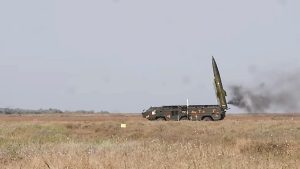

Tochka Missile, Photo of Likely Strike during the RUW: Source- frontierindia.com/nitter.net
Bayraktar UAS. On 27 February, Ukrainian Air Force confirmed two strikes by Bayraktar TB2 UAS on Russian convoys. According to video footage, TB2 UAS successfully destroyed a Russian tank, SAM systems and two Russian fuel trains, making the UAS a lethal component of the Ukrainian Armed Forces. This Medium-Altitude-Long-Endurance (MALE) UAS is capable of remote-controlled and autonomous operations. It comes in surveillance as well as combat (armed) versions and is manufactured by the Turkish Company Baykar, which specialises in UAS, C4I and Artificial Intelligence technologies. The UAS has a top speed of 220 Kmph, with a range of 150 Km, operational altitude of 5.5 Km and endurance of 27 hours. It has four hardpoints, which can carry a combination of the L-UMTAS (Long Range Anti-tank Missile System), Turkish weapons manufacturer Rokestan’s Precision Guided Smart Micro Munitions (MAM-L/C), laser-guided rockets or 81mm air-to-surface mortar munitions.



Bayraktar TB2 of the Ukrainian Air Force armed with MAM-L, L-UMTAS, MAM-L/C: Source- Wikipedia
Conclusion
While the assessed outcome of the RUW and the ensuing impact on India’s Armed Forces Inventory are yet to be fully gauged and are beyond the scope of the present article, India would need to continuously engage with Russian/Ukrainian Governments and defence manufacturers to obviate any shocks to existing imports/arrangements like the S-400, nuclear submarine lease deal and the scheduled equipment upgrades to the inventories of the three Services. All said and done, the RUW is bound to have long-term economic an
Disclaimer
The opinions expressed in this article are the author’s own and do not reflect the views of Chanakya Forum. All information provided in this article including timeliness, completeness, accuracy, suitability or validity of information referenced therein, is the sole responsibility of the author. www.chanakyaforum.com does not assume any responsibility for the same.
Chanakya Forum is now on . Click here to join our channel (@ChanakyaForum) and stay updated with the latest headlines and articles.
Important
We work round the clock to bring you the finest articles and updates from around the world. There is a team that works tirelessly to ensure that you have a seamless reading experience. But all this costs money. Please support us so that we keep doing what we do best. Happy Reading
Support Us





















POST COMMENTS (0)